Origins:
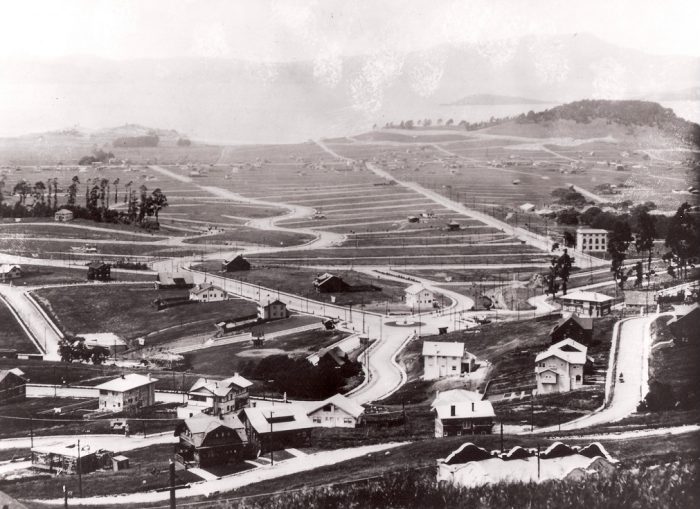
The Circle and Fountain Walk, which links The Circle to the streets below, are the focal points of Northbrae, an area which Mason and McDuffie developed at the beginning of the century. Northbrae tract in north Berkeley was the second Berkeley development project of Joseph J. Mason, a Berkeley real estate promoter, and his partner, Duncan McDuffie. Their first project was the Claremont tract (1905), which was widely praised for its naturalistic layout and park-like feeling. On 4 September 2011, the Berkeley Daily Gazette wrote in a small article “Big Fountain for Northbrae”, that the original cost of the fountain was $2,500. On 7 October 1911, the Berkeley Daily Gazette (from the SF Public Library newspaper archives) has an ad for Northbrae Properties, advertising the “Putnam Fountain”, saying that “the water will run forever without cost to the people of Berkeley from immense concrete cisterns built under Northbrae streets several blocks away, fed by living springs of Northbrae Properties.”
Duncan McDuffie was a UC graduate and an early member of the Sierra Club. He had a vision of land development, which preserved the environment and respected the natural features of the land. He sought out the most talented and farsighted architects, landscapers and artisans as team members in his development of open land. He retained John Galen Howard, a leading Bay Area architect and poet and foremost architect for the University of California (Supervising Campus Architect-UC Campanile, Sather Gate, Mining Circle pool, & Doe Library), to design architectural features for Northbrae Properties.
The Circle:
When Howard laid out his urban plan to shape open spaces for residential use, he made The Circle the central design element. The Circle is a roundabout originally planned as a hub for rail traffic. Now it is a rather harrowing auto hub used by about 30,000 cars a day with seven streets radiating from The Circle like spokes from a wheel. A fountain, also designed by Howard and completed in 1911, sat in the center of The Circle. It was 9′ tall with a shallow pool 25′ wide and the center and spout were held by sculptures of four grizzly bear cubs, sculpted by Arthur Putnam. A train station designed by Howard at Del Norte and Hopkins and the extensive rail system, of course, have all since been demolished. The Beaux Arts plan of The Circle is a treasure from Berkeley’s rich architectural past. The fountain was the City’s first public work of art.
Fountain Walk:
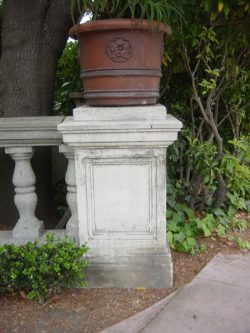
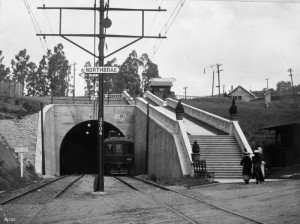 Fountain Walk joins The Circle to Del Norte at the entrance to Solano Tunnel. A grand balustrade surrounds The Circle area, running beside the arcing streets, curbs and sidewalks. The same balustrade continues down both sides of Fountain Walk. Large terra cotta planters mark the end of each section of balustrade and also appear at the top, bottom, and middle section of Fountain Walk.
Fountain Walk joins The Circle to Del Norte at the entrance to Solano Tunnel. A grand balustrade surrounds The Circle area, running beside the arcing streets, curbs and sidewalks. The same balustrade continues down both sides of Fountain Walk. Large terra cotta planters mark the end of each section of balustrade and also appear at the top, bottom, and middle section of Fountain Walk.
Berkeley, the Capital of California?:
Perhaps the most intriguing aspect of Northbrae’s history was its part in a failed scheme to make Berkeley the capital of California. In 1908, the developer John Spring, who owned properties which stretched from Grizzly Peak to the Bay, began lobbying in Sacramento to promote this idea. The capitol building was planned to be located on a piece of land by Indian Rock. One of the streets around The Circle was named Los Angeles, in an attempt to attract Southern California voters who were not enthusiastic about changing the site. The Circle and the fountain were part of a proposed grand entry. The California Legislature passed the proposal and the governor signed the bill, but Berkeley was a dry city and the liquor lobbyists were successful in convincing the voters to narrowly defeat the bill.
Disrepair and loss:
By the late 1950’s the fountain was in disrepair and the gravity operated, spring fed water source no longer operated. On 17 October 1957, shortly after 4pm, a run-away truck demolished the fountain. The truck belonged to the Elliott and Elliott Roofing Company, and was full of roofing debris. The brakes failed about 2½ blocks up Marin, and the truck reached 60 miles per hour, as reported in an article by the Oakland Tribune on 18 October (from the SF Public Library newspaper archives). The Berkeley Daily Gazette also ran an article on 18 October 1957 about the crash with vivid details and spectacular photos of the destroyed fountain, the truck and the curious crowd. There was another crash (fatal) in an article in the SF Chronicle on 16 July 1957 (also from the SF Public Library newspaper archives), but the fountain was spared.
Reconstruction:
 Thirty-five years after the untimely destruction of the fountain, Phil O’Hay, a contractor who lives close to The Circle, was intrigued by the idea of replacing the fountain and began looking at companies that made fountains. Meanwhile, Gail Keleman and Emmy Sortor were working on clearing Fountain Walk and repairing the stairs and the balustrades and replacing five missing terra cotta pots (there are a total of twenty-two pots) and repotting them. Shirley Dean, who was the Mayor of Berkeley at the time, introduced these two separate interest groups and in 1993 the non-profit volunteer organization Friends of the Fountain and Walk was born. Friends of the Fountain and Walk raised over $100,000. A dozen local businesses contributed sizable amounts up to $1,000. and over 1200 individuals contributed from $1. – $1,000. making this the largest grassroots effort in Berkeley’s history for the improvement of a public space.
Thirty-five years after the untimely destruction of the fountain, Phil O’Hay, a contractor who lives close to The Circle, was intrigued by the idea of replacing the fountain and began looking at companies that made fountains. Meanwhile, Gail Keleman and Emmy Sortor were working on clearing Fountain Walk and repairing the stairs and the balustrades and replacing five missing terra cotta pots (there are a total of twenty-two pots) and repotting them. Shirley Dean, who was the Mayor of Berkeley at the time, introduced these two separate interest groups and in 1993 the non-profit volunteer organization Friends of the Fountain and Walk was born. Friends of the Fountain and Walk raised over $100,000. A dozen local businesses contributed sizable amounts up to $1,000. and over 1200 individuals contributed from $1. – $1,000. making this the largest grassroots effort in Berkeley’s history for the improvement of a public space.
This project involved the City of Berkeley, East Bay Municipal Utility District (EBMUD), Pacific Gas & Electric (PG&E), volunteer efforts, neighbors, services, materials and labor donated by professionals. Dura Art Stone in Newark, California, a well-known architectural casting firm, manufactured the fountain.
Since none of the original fountain parts remained, the specifications and molds of the fountain were resurrected and developed by Robert Ludlow AIA and Charles E. Wilson ASLA from the original Howard design drawing, a scale drawing of the fountain, and from old photos.
The Bears were originally made by famous animal sculptor Arthur Putnam. The original drawings of the bears (symbolizing both the University and the State of California), acanthus leaf finial and volutes were not found, so Sarita Waite, the sculptor for the reconstruction, reviewed Putnam’s life and other works to recreate his style.
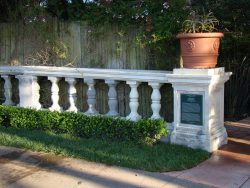 One of the original terra cotta pots was removed and taken to Gladding, McBean in Lincoln, California where they have their own source of terra cotta and they were able to match the color and texture. They also have giant kilns large enough to accommodate the size of the pots.
One of the original terra cotta pots was removed and taken to Gladding, McBean in Lincoln, California where they have their own source of terra cotta and they were able to match the color and texture. They also have giant kilns large enough to accommodate the size of the pots.
With the help of volunteers and landscaper Bill Steele of Land Art, we were able to recreate the original landscape of grass and boxwoods in time for our dedication ceremony.
Reconstruction Timeline:
Many people volunteered their time and talents over the years for the reconstruction of the fountain.
1994
Reconstruction of the steps and balustrades at Fountain Walk and The Circle was completed
1995
Five terra cotta pots, duplicates of the originals, were made by special order by Gladding, McBean and installed and all twenty-two pots were replanted
June 1995
Digging began for the vault (where the pump and motor, etc. are housed)
January 1996
Dura Art Stone began casting the fountain and art work
February 1996
The bottom pool was poured (25 feet in diameter)
June 1996
The fountain is delivered and masons begin assembling the pieces
August 1996
The art work (bears, finial and volutes) are installed
September 15, 1996
The dedication of the fountain is held
Re-dedication:
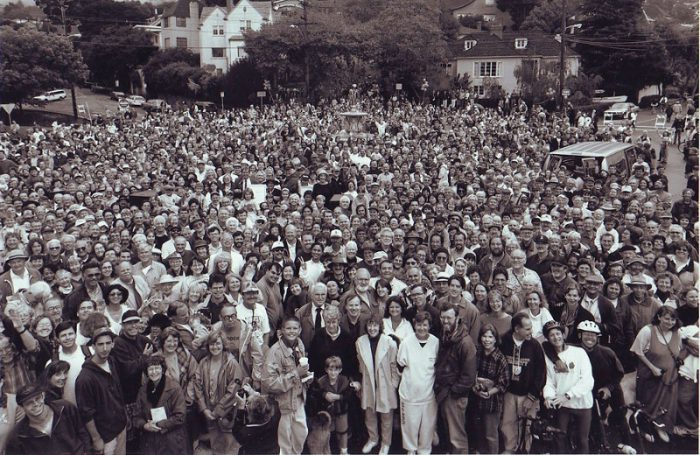 Mayor Shirley Dean arrived in a 1912 fire truck for the dedication ceremony on September 15, 1996. The streets around the fountain were closed, we had speeches, and we had vintage automobiles on display that belonged to local residents. We gave away gingerbread bear cookies, molded after the bear cub sculptures on the fountain, that were made by volunteers at a local bakery, and we sold commemorative T-shirts and note cards. We had 1500 programs printed and distributed. There were about 3000 people there that day to share in the special feeling that this restoration project created. Even if people had not participated with time or money in the project, they felt it was their fountain just the same. There was a community spirit and energy that was noticed and experienced by all and has not faded away.
Mayor Shirley Dean arrived in a 1912 fire truck for the dedication ceremony on September 15, 1996. The streets around the fountain were closed, we had speeches, and we had vintage automobiles on display that belonged to local residents. We gave away gingerbread bear cookies, molded after the bear cub sculptures on the fountain, that were made by volunteers at a local bakery, and we sold commemorative T-shirts and note cards. We had 1500 programs printed and distributed. There were about 3000 people there that day to share in the special feeling that this restoration project created. Even if people had not participated with time or money in the project, they felt it was their fountain just the same. There was a community spirit and energy that was noticed and experienced by all and has not faded away.
Interesting facts about the fountain:
The fountain, a gift to the City of Berkeley from the Friends of the Fountain and Walk, was valued at the time of the dedication at $175,000, including donated professional services, material and labor.
The bottom pool of the fountain is poured concrete, with 40 pre-cast concrete pieces making up the sides, each weighing 440 pounds. It took a crane one day to lift all the pieces into place.
State-of-the-art diverters and high-quality pumps operate the fountain.
The fountain recirculates 200 gallons of water per minute.
Four underwater lights are installed in niches cast into the bottom pool and each of the other two tiers of the fountain also has four lights each.
The fountain is fitted with an anti-vortex device to prevent entrapment.
Thirty-three break away concrete bollards, with a total weight of two tons, separate the fountain from the motoring public.
The surrounding balustrade is about 700 feet long, including Fountain Walk down to the tunnel. It includes 408 full and 140 half balusters. The top rail is about 6 inches thick, and the bottom rail is about 3 inches thick on a thicker base.
Friends of the Fountain and Walk continued involvement with the City:
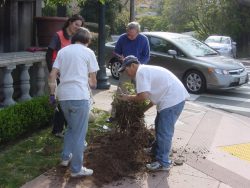
 Although the fountain is on City property and they have a regular schedule for mowing, watering and servicing the filters, etc., Friends of the Fountain and Walk is still very involved as a group of volunteers. We are continuing to raise funds for ongoing maintenance, to add enhancements to the fountain such as additional lighting (completed) and occasionally to help with the cost of repairs. The first Saturday of every month, volunteers weed, pick up trash, remove graffiti, trim the boxwood hedge and sweep the gutters, etc. around the perimeter of the fountain and on Fountain Walk. We first started with only one green yard debris can and we now have four cans. We also help as needed to service the fountain in between the City’s scheduled times. The City is very cooperative.
Although the fountain is on City property and they have a regular schedule for mowing, watering and servicing the filters, etc., Friends of the Fountain and Walk is still very involved as a group of volunteers. We are continuing to raise funds for ongoing maintenance, to add enhancements to the fountain such as additional lighting (completed) and occasionally to help with the cost of repairs. The first Saturday of every month, volunteers weed, pick up trash, remove graffiti, trim the boxwood hedge and sweep the gutters, etc. around the perimeter of the fountain and on Fountain Walk. We first started with only one green yard debris can and we now have four cans. We also help as needed to service the fountain in between the City’s scheduled times. The City is very cooperative.
This project is unique. This was one of the first joint projects between the City and the community, and they felt it was so successful that they have encouraged other groups to organize and work with them.
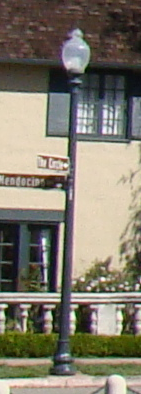 After the restoration was completed, a utilities project put the utilities underground and replaced the street lighting. Friends of the Fountain and Walk raised money to upgrade the street lighting from the utilitarian steel davit pole (standard street light) to a very nice looking, and period-appropriate street light, that completed the look of The Circle and the fountain. We also use the money from our fundraising for ongoing maintenance of the fountain and landscape.
After the restoration was completed, a utilities project put the utilities underground and replaced the street lighting. Friends of the Fountain and Walk raised money to upgrade the street lighting from the utilitarian steel davit pole (standard street light) to a very nice looking, and period-appropriate street light, that completed the look of The Circle and the fountain. We also use the money from our fundraising for ongoing maintenance of the fountain and landscape.
Awards and Recognition:
This project won a public service honor award from the American Institute of Architects (California Council) that was presented April 5, 1997 and we also won an award from BAHA (Berkeley Architectural Heritage Association) for Outstanding Reconstruction that was presented on May 22, 1997. And in December 1997 the project also received an award of excellence from the Berkeley Design Advocates. On October 21, 1999 the Berkeley Community Fund gave special recognition to the project for improving the quality of public life.
The fountain was in the foreground on the Alameda/Contra Costa County (AC) Transit home page web site in 2003. Also, some of the local businesses use the fountain as their logo or in advertising.
Public Enjoyment:
While we do not encourage the public to walk out to the fountain due to the traffic (there are benches around the perimeter), it is a popular spot for photographs of wedding parties and other special occasions. Also, artists are drawn to the fountain to reproduce it in the form of sketches, pastels and watercolors. When volunteers are maintaining the fountain, motorists driving around the fountain will often shout out how much they appreciate the fountain and the work of all of the volunteers.







